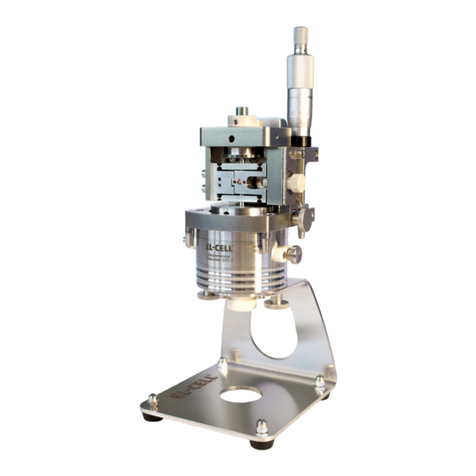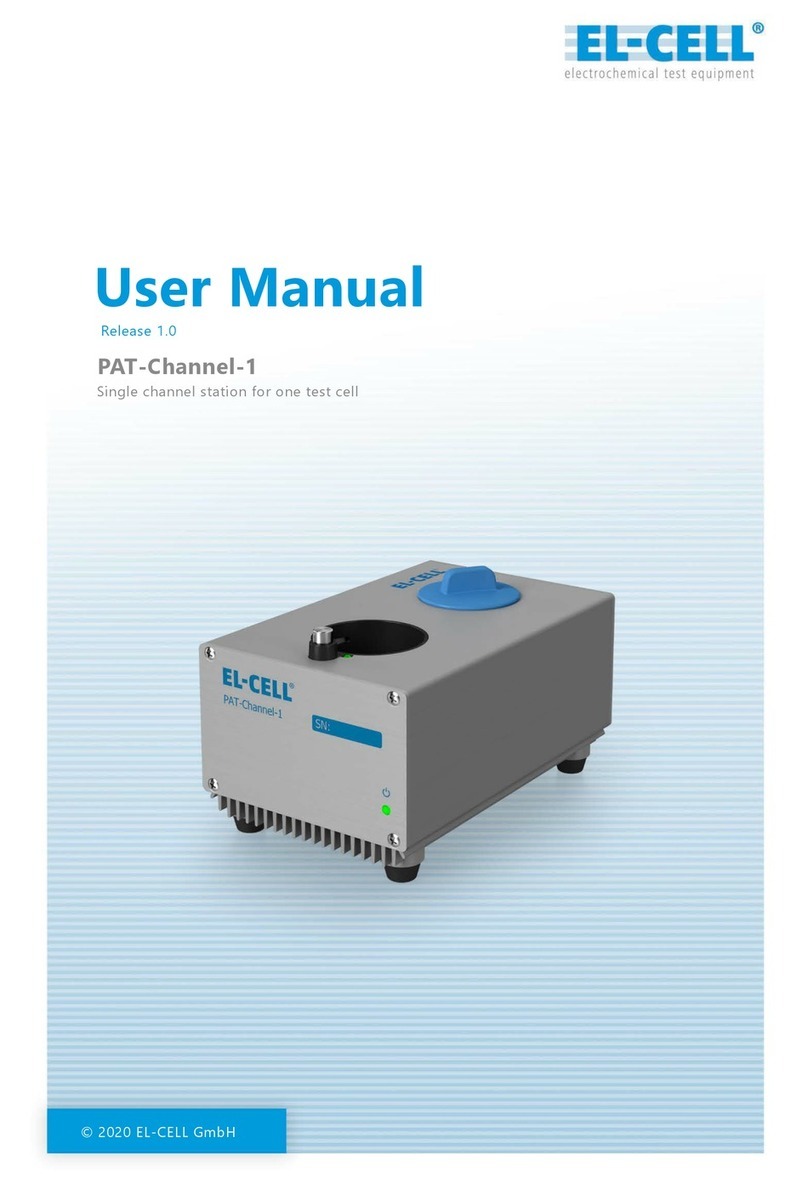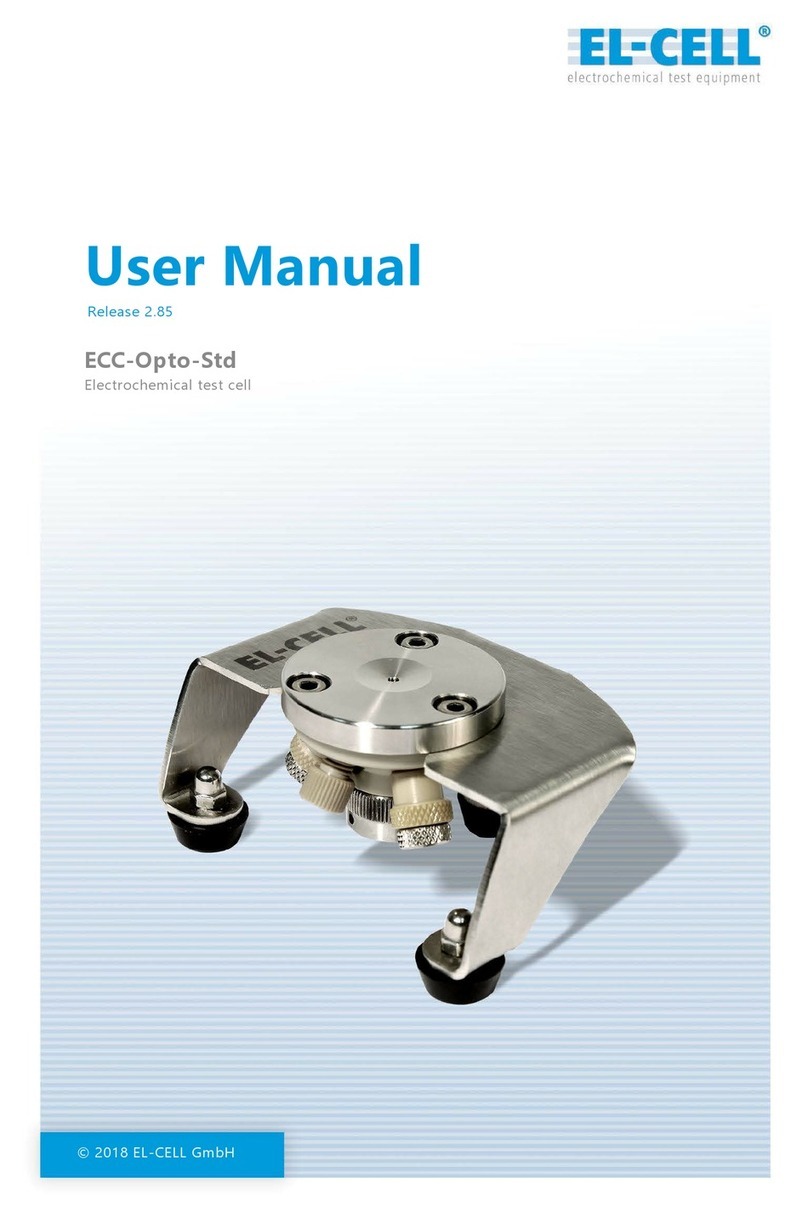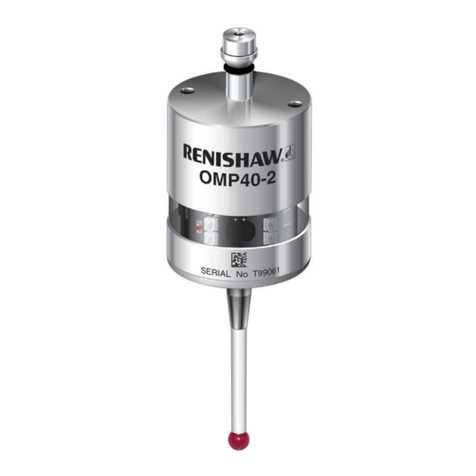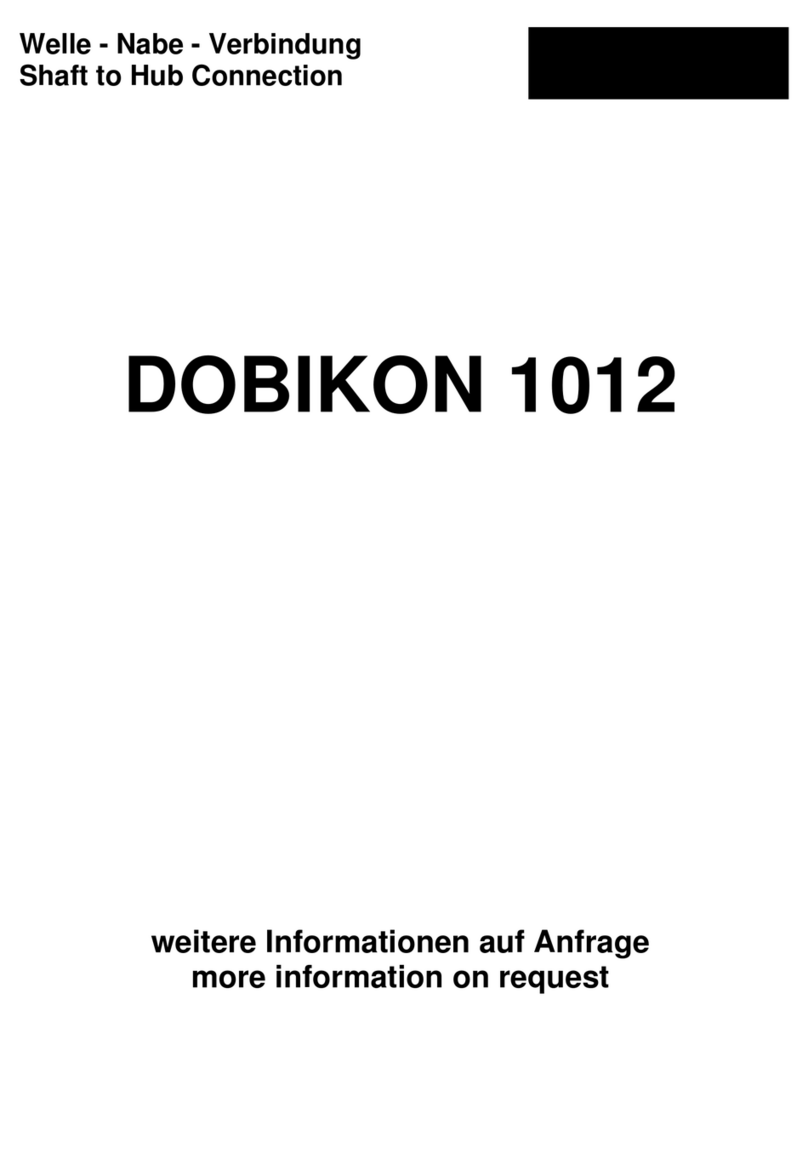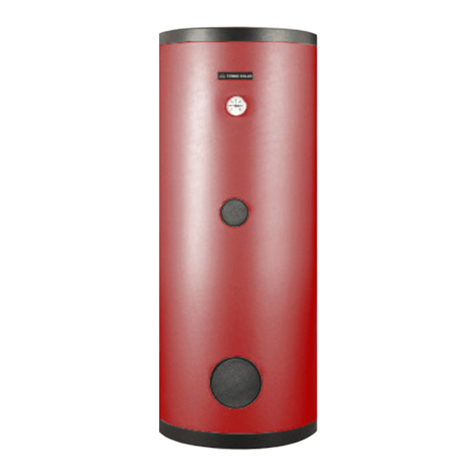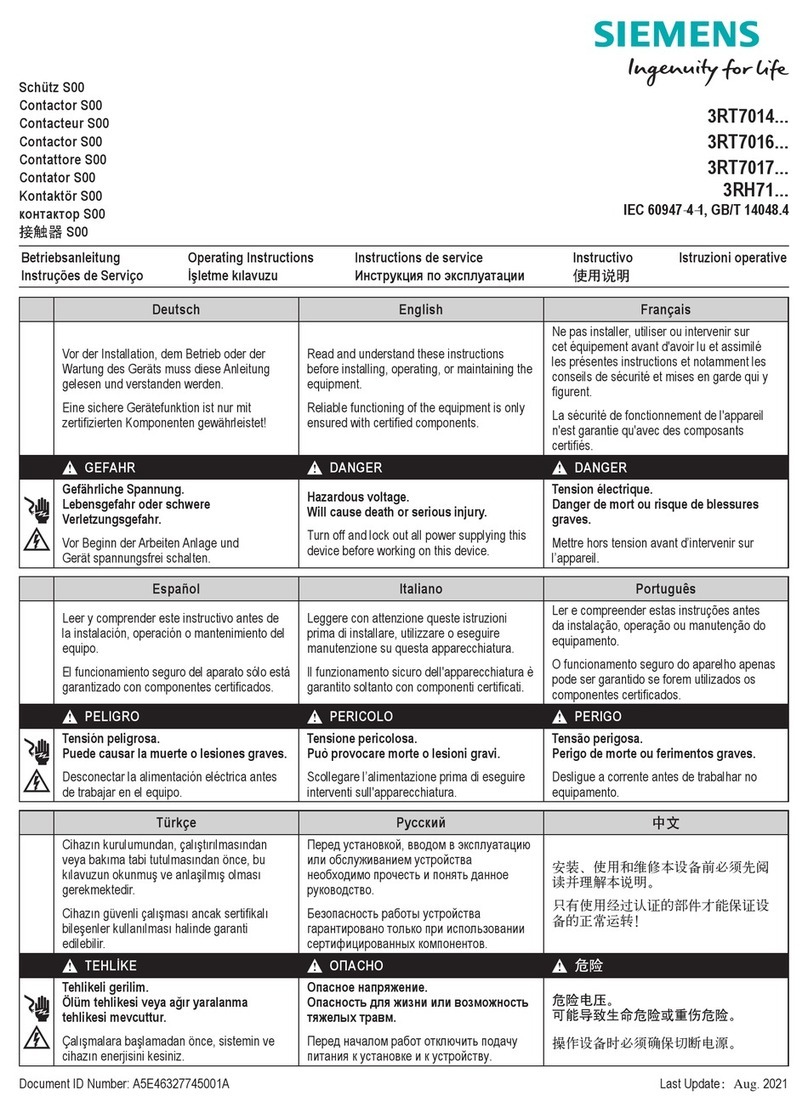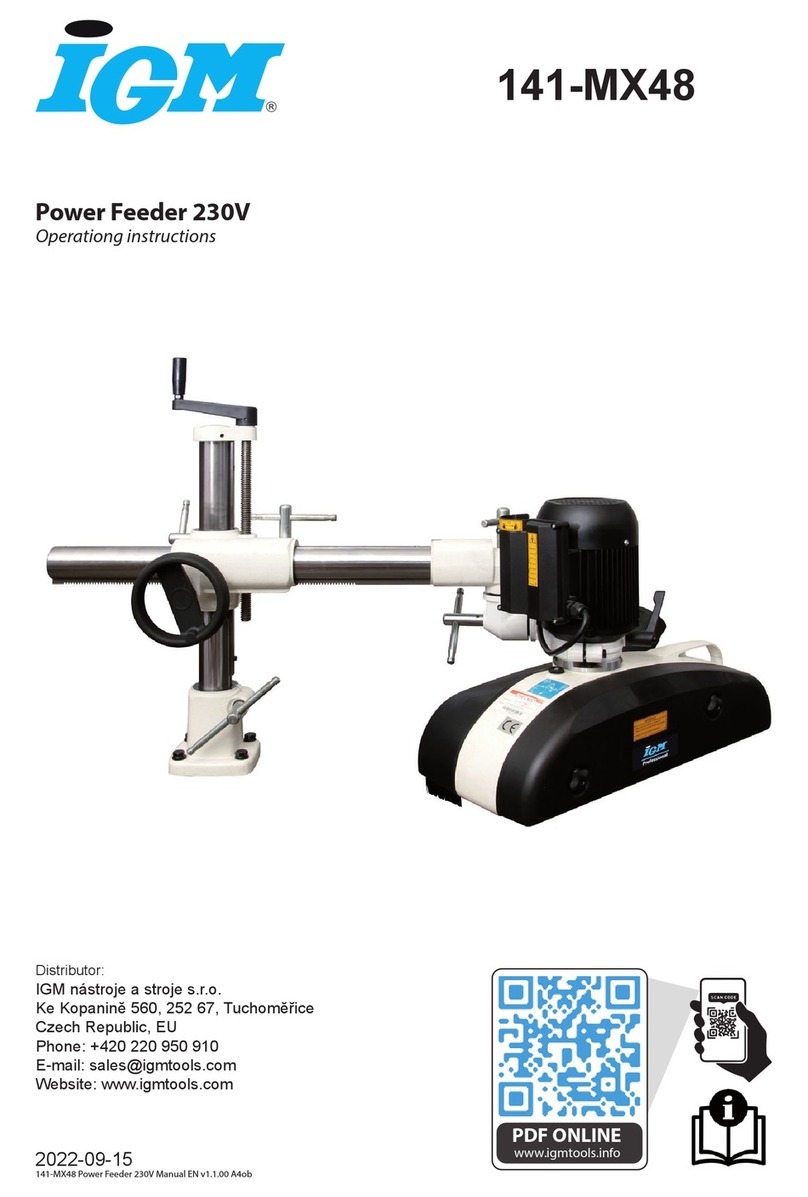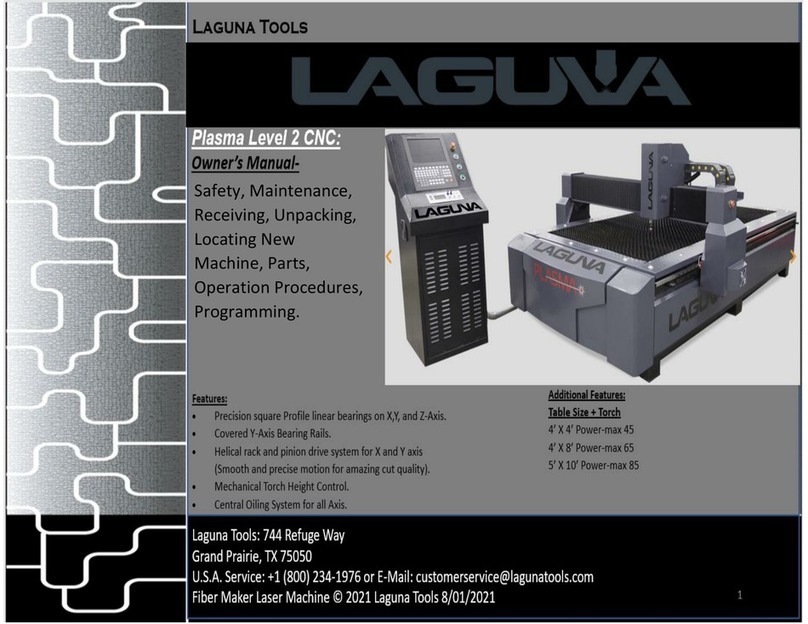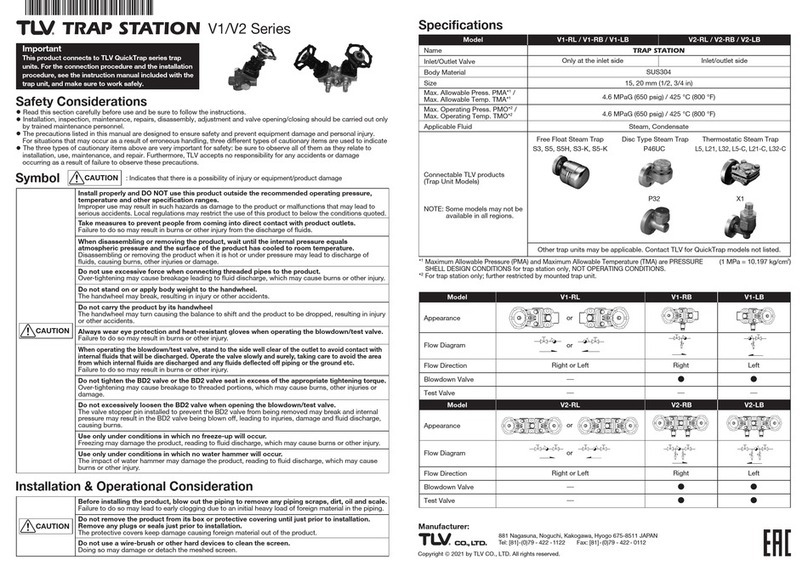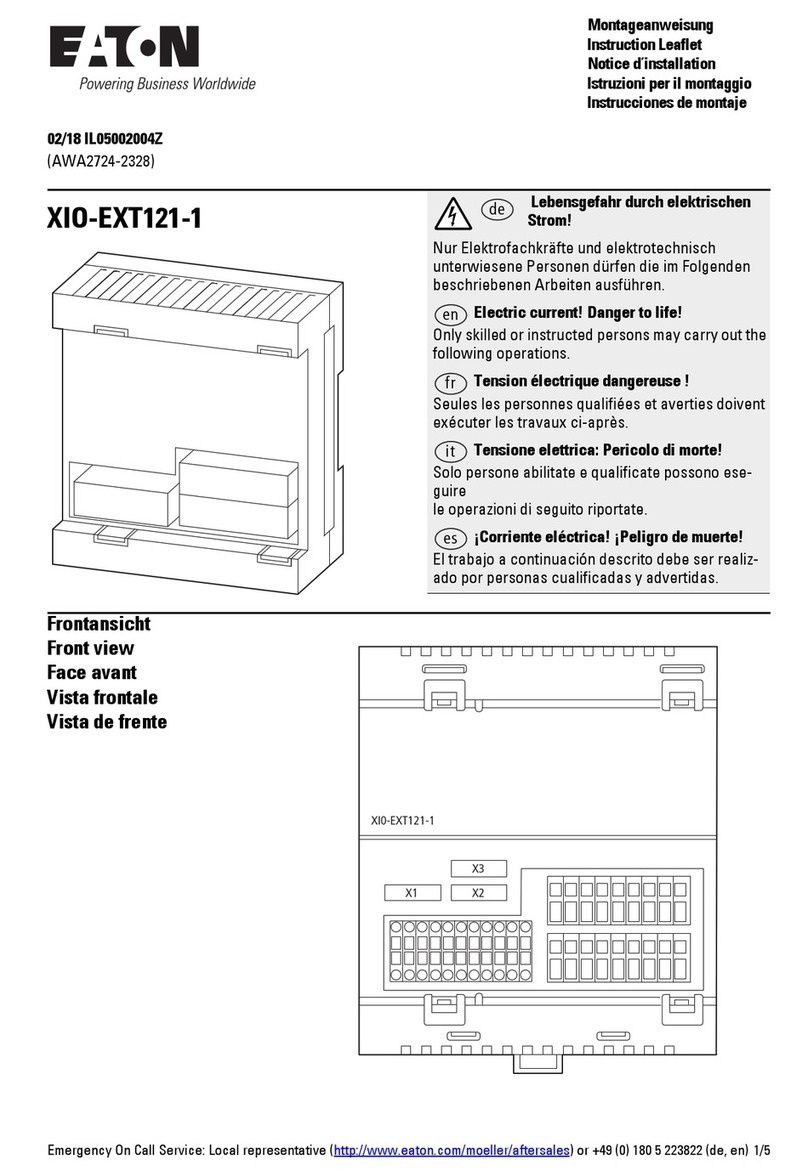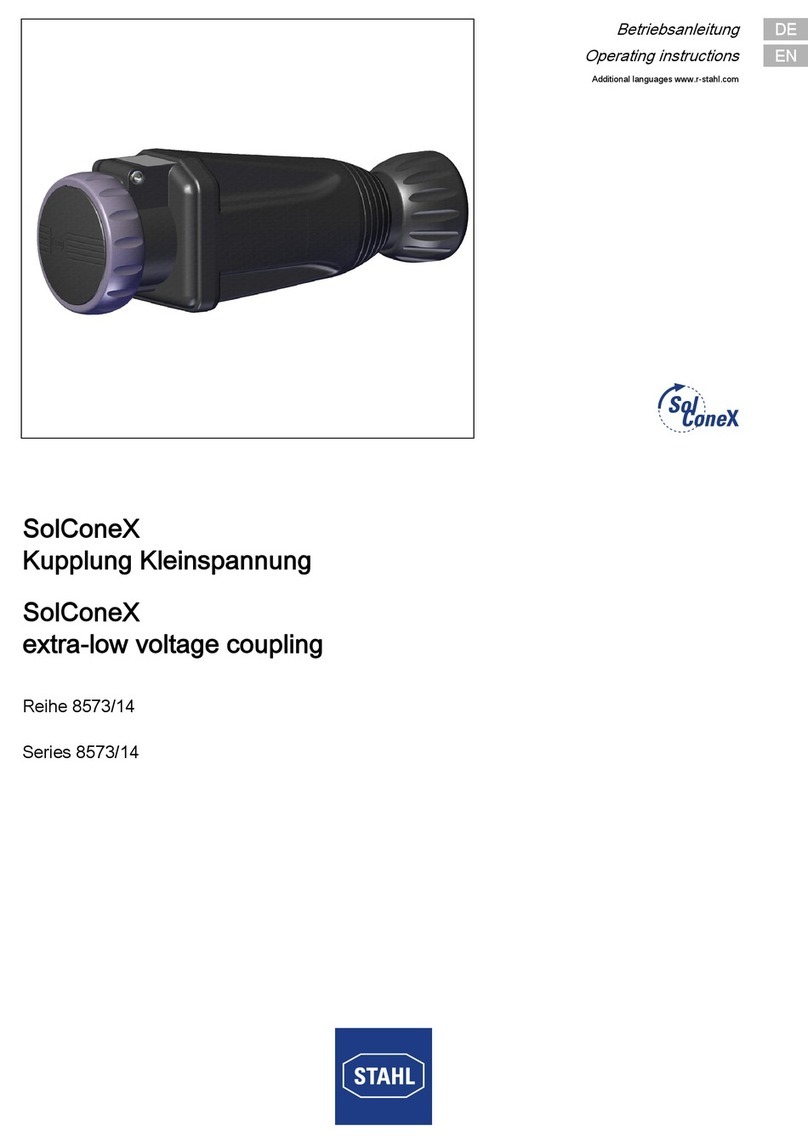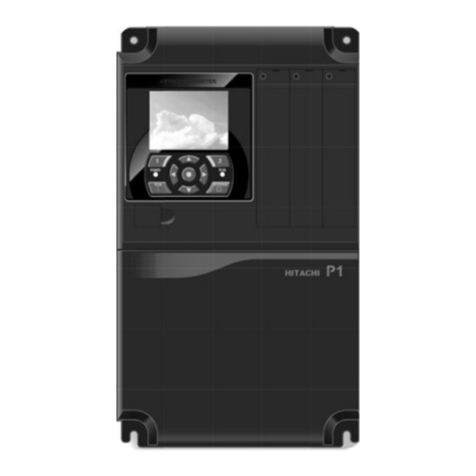EL-CELL ECC-Opto-Std-Aqu User manual

© 2020 EL-Cell GmbH
User Manual
Release 1.56
ECC-Opto-Std-Aqu
Electrochemical test cell

Page 2 of 19
User Manual ECC-Opto-Std-Aqu
Release 1.56
The information in this manual has been carefully checked and believed to be accurate;
however, no responsibility is assumed for inaccuracies.
EL-Cell GmbH maintains the right to make changes without further notice to products
described in this manual to improve reliability, function, or design. EL-Cell GmbH does not
assume any liability arising from the use or application of this product.
EL-Cell GmbH
Tempowerkring 8
21079 Hamburg - Germany
phone: +49 40 79012-737
fax: +49 40 79012-736
e-mail: info@el-cell.com
web: www.el-cell.com

Page 3 of 19
User Manual ECC-Opto-Std-Aqu
Release 1.56
Content
1 Product description ...................................................................................................................................... 4
2 Features............................................................................................................................................................ 5
3 Safety precautions......................................................................................................................................... 7
4 Assembly and connection ........................................................................................................................... 7
5 Disassembly and Cleaning .......................................................................................................................... 9
6 Windows for ECC-Opto-Std-Aqu .............................................................................................................. 9
7 Cell holders ...................................................................................................................................................11
8 Unpacking......................................................................................................................................................13
9 Technical data ..............................................................................................................................................14
10 Spare parts..................................................................................................................................................15
ECC-Opto-Std-Aqu test cell ..........................................................................................................................15
11 Technical support......................................................................................................................................19
12 Warranty ......................................................................................................................................................19

Page 4 of 19
User Manual ECC-Opto-Std-Aqu
Release 1.56
1 Product description
The ECC-Opto-Std-Aqu test cell is a version of the ECC-Opto-Std test cell specialized to highly
corrosive aqueous and non-lithium aprotic electrolytes. For this purpose, current collectors are
made of gold (optional nickel or platinum) replacing stainless steel. One restriction must be
noted: Gold current collectors are not fully compatible with aprotic lithium based electrolytes,
as lithium may alloy with gold at very low potentials. Having this in mind, the ECC-Opto-Std-
Aqu may be operated in almost the same way as the ECC-Opto-Std. The present manual only
covers the standard sandwich operation mode. For the alternative side-by-side arrangement
of electrodes, please refer to the manual of the ECC-Opto-Std.
Stand
ECC-Opto-Std-Aqu Cell
Lid
Cell body
Port REF
Port B
Port A
Touch screw

Page 5 of 19
User Manual ECC-Opto-Std-Aqu
Release 1.56
2 Features
2- and 3-electrode cell with optical window for highly corrosive aqueous and non-lithium
aprotic electrochemistry.
Materials in media contact are gold, PEEK and EPDM
In the standard sandwich set-up, the backside of the disc-shaped working electrode
material supported on a holed or meshed current collector can be observed through the
optical window on top. The inspection area diameter is 2 mm by default (up to 10 mm
optionally).
Alternative side-by-side set-ups allow using electrode strips supported on continuous
current collectors (metal foils) as both working and counter electrode. The strips can
easily be cut off from single sided electrode films.
Typically used in combination with optical or Raman microscopy in the reflection mode.
X-ray option with Beryllium window available.
The provided optical window is made of borosilicate glass. Sapphire, beryllium,
polyimide and other window materials are available on request.
Easy and clean electrolyte filling via the vacuum (syringe) method.
All necessary equipment is included.
Cell assembly and filling may be carried out inside a glove box. Once sealed, the cell may
be operated outside the box at ambient atmosphere.
Small and defined electrolyte volume down to 0.1 cm3due to minimized dead volume
Connection to potentiostat/battery tester via 2 mm banana sockets, adapters for 4 mm
banana sockets are included
Temperature operation range -20 to +70 °C

Page 6 of 19
User Manual ECC-Opto-Std-Aqu
Release 1.56
Working principle of the ECC-Opto-Std-Aqu (shown for the sandwich set-up):
Optical window
Holed current collector
16 mm
Spring loaded
piston
Working electrode
material (WE) placed on
the holed current collector
Glass fiber separator
Counter electrode
(CE)
Inspection area (2 mm,
optional up to 10 mm)
Reference electrode pin
Working electrode contact pin

Page 7 of 19
User Manual ECC-Opto-Std-Aqu
Release 1.56
3Safety precautions
Use proper safety precautions when using hazardous electrode materials and electrolytes.
Wear protective glasses and gloves to protect you against electrolyte that may accidentally
spill out during filling and disassembly. Upon cell disassembly, dispose all materials properly.
4Assembly and connection
The test cell can be used in several different configurations, which mainly differ in the type
and size of the working electrode used, the charging geometry (the position of working and
counter electrode relative to each other), and the connection to the potentiostat (2 - or 3-
electrode connection). In the following, the cell assembly is described for the standard
sandwich geometry using PTFE bound activated carbon as the electrodes and aqueous sulfuric
acid as the electrolyte.
Assembly:
1. Load a small amount of PTFE bound activated carbon into the REF opening of the cell body. This
reference material will later on be contacted by the reference pin mounted into port REF.
2. Push the counter electrode piston into the cell body to the uppermost position.
3. Pull the piston slightly back, and insert the gold current collector disc and the activated
carbon counter electrode (max. 10 mm in diameter, max. 1 mm thick)
4. Put the provided glass fiber separator on top.
5. Place a self-standing PTFE-bound activated carbon electrode on top of the separator. The
electrode must be larger than the 1 mm hole in the current collector, and should not exceed the
10 mm diameter of the counter electrode.
6. Cover the working electrode with the provided holed current collector. Note that, in the
fully assembled state, the ductile working electrode will be pressed against the window on top.
This way, the incident beam shines directly on the backside of the WE, and does not have to
pass an electrolyte layer.
7. Insert the upper O-Ring seal (16 x 1.8 mm) into the cell body, and place the glass
window on top. Make sure that the window is in the center position.
8. Attach the lid and fasten the three socket screws.
9. Attach the WE contact pin to port A.
10. Attach the reference pin to the reference port. Plug the reference port if working
without reference electrode.
11. Attach the touch screw from below and raise it to the uppermost position; then turn the
touch screw back (counter clockwise) by about 30°.

Page 8 of 19
User Manual ECC-Opto-Std-Aqu
Release 1.56
12. Fill the cell with electrolyte (e.g. 3Msulfuric acid) according to the following procedure:
Connect the provided transfer line to port B.
Charge a 5 ml syringe with ca. 0.2 ml of electrolyte.
NOTE: We recommend single-use PP plastic syringes with low friction silicone pistons.
Connect the syringe to the Luer adapter of the transfer line.
Pull the syringe piston back to evacuate the cell. Hold the piston a few seconds in the
strained position.
Make sure that the tip of the syringe points downwards. Then release the piston, so
that the electrolyte is sucked into the cell by the previously applied vacuum.
NOTE: Never pressurize the cell during the filling procedure.
Remove the transfer line and close port B with the second contact pin.
13. Insert the cell into the stand.
14. Connect the cell cable as shown in the picture below.
15. Connect your potentiostat to the 2 mm sockets (1) of the cell cable ( grey: REF; red: WE;
blue: CE). Adapters (2) are provided for connection to 4 mm banana plugs.

Page 9 of 19
User Manual ECC-Opto-Std-Aqu
Release 1.56
5Disassembly and Cleaning
After use, disassemble the test cell in the reverse order of assembly. Dispose electrodes and
electrolyte properly. Clean wetted cell parts with deionized water and/or other appropriate
detergent wash and solvent. Cell base and CE piston may be additionally cleaned in an
ultrasonic bath. After cleaning with water, dry parts with compressed air. If working with
aprotic electrolytes, and before building a new cell, dry parts overnight at 80°C under vacuum.
This treatment is essential for PEEK parts and EPDM O-ring seals as these parts may absorb
water.
NOTES:
Protect yourself against chemical hazards. Electrolyte may spill out during cleaning.
Electrode materials and electrolyte may react with ambient atmosphere or solvents used
for cleaning. Wear appropriate protection equipment, goggles and gloves.
Clean all cell parts right after disassembly. Leaving cell parts in contact with ambient
atmosphere while still being wetted with electrolyte may result in severe corrosion.
6Windows for ECC-Opto-Std-Aqu
ECC-Opto Borosilicate glass window
(standard)
List of Components:
1. Glass window (1 pc, 22 x 0.3 mm) LAB0018
2. Lid (1 pc) ECC1-00-0127-A
ECC-Opto Beryllium window kit
ECC1-00-0156-B
List of Components:
1. Beryllium window (1 pc, 22 x 0.2 mm) ECC1-00-0222-A
2. Lid (1 pc) ECC1-00-0127-C

Page 10 of 19
User Manual ECC-Opto-Std-Aqu
Release 1.56
ECC-Opto Beryllium window kit II
ECC1-00-0156-F
List of Components:
1. Beryllium window (1 pc, 22 x 0.2 mm) ECC1-00-0222-A
2. Lid (1 pc) ECC1-00-0127-M
ECC-Opto Polyimide window kit:
ECC1-00-0156-F
List of Components:
1. Polyimide (Cirlex) window (3 pcs, 22 x 0.23 mm) ECC1-00-0250-A
2. Lid (1 pc) ECC1-00-0127-C
ECC-Opto Zinc selenide window kit:
ECC1-00-0156-D
List of Components:
1. Zinc Selenide window (1 pc, 22 x 1.0 mm) ECC1-00-0250-B
2. Lid (1 pc) ECC1-00-0127-E
ECC-Opto Calcium fluoride window kit:
ECC1-00-0156-E
List of Components:
1. Calcium fluoride window (1 pc, 22 x 1.0 mm) ECC1-00-0250-C
2. Lid (1 pc) ECC1-00-0127-E

Page 11 of 19
User Manual ECC-Opto-Std-Aqu
Release 1.56
ECC-Opto Sapphire window kit:
ECC1-00-0156-C
List of Components:
1. Sapphire window (1 pc, 22 x 0.3 mm) ECC1-00-0149-A
2. Lid (1 pc) ECC1-00-0127-B
ECC-Opto Polyester window kit:
ECC1-00-0156-G
List of Components:
1. Polyester (PET) window (3 pcs, 22 x 0.25 mm) ECC1-00-0250-G
2. Lid (1 pc) ECC1-00-0127-C
7Cell holders
Cell holder I for ECC-Opto-Std
ECC1-00-0414-A
Measurements:
Height: 32 mm
Width: 75 mm
Depth: 50 mm

Page 12 of 19
User Manual ECC-Opto-Std-Aqu
Release 1.56
Cell holder II for ECC-Opto-Std
ECC1-00-0335-A
Measurements:
Height: 41.8 mm
Width: 78 mm
Depth: 76 mm
Designed for Bruker D8
Note: Only in combination
with Lid ECC1-00-0127-M
Cell holder III for ECC-Opto-Std
ECC1-00-0419-A
Measurements:
Height: 20 mm
Width: 75 mm
Depth: 61.5 mm
Designed for Bruker FTIR Hyperion 2000.
Note: The cell holders for our optical test cells can be customized on request.

Page 13 of 19
User Manual ECC-Opto-Std-Aqu
Release 1.56
8Unpacking
Check the contents of the packages against the list given below to verify that you have
received all of the required components. Contact EL-CELL, if anything is missing or damaged.
NOTE: Damaged shipments must remain within the original packaging for freight company
inspection.
List of components:
ECC-Opto-Std-Aqu test cell with stand, fully equipped for use in both 2-electrode and
3-electrode (reference) configuration in aqueous electrolytes
ECC-Opto cell cable ECE1-00-0075-A
2
1
2
1
3
4
5
6
7
8
9
10
11

Page 14 of 19
User Manual ECC-Opto-Std-Aqu
Release 1.56
Glass windows (5 pieces) LAB0018/V
Glass fiber separators (5 pieces) ECC1-01-0012-J/V
Feed wire (Au), assy ECC1-00-0010-O
Transfer line syringe (5 ml) for vacuum filling ECC1-01-0001-A
O-Ring 6.75 mm x 1.78 mm DIC9013
O-Ring 16 mm x 1.8 mm DIC9012
Hex wrench 0.9 mm WZG9005
Current Collector 10mm, Au ECC1-00-0159-A
Spherical hex screw driver 3 mm WZG9002
9Technical data
Height / Width / Depth: : 46 / 88 / 64 mm
Weight: approx. 0.2 kg
Electrode diameter: 10 mm
Electrolyte volume: min. 0.1 ml
Temperature operation range -20 to +70 °C
3
4
5
6
7
8
9
10
11

Page 15 of 19
User Manual ECC-Opto-Std-Aqu
Release 1.56
10 Spare parts
ECC-Opto-Std-Aqu test cell

Page 16 of 19
User Manual ECC-Opto-Std-Aqu
Release 1.56
Central CE Piston
ECC-OPTO-STD AQU
ECC1-00-0180-B

Page 17 of 19
User Manual ECC-Opto-Std-Aqu
Release 1.56
REF electrode OPTO, assy (Au)
ECC1-00-0010-R

Page 18 of 19
User Manual ECC-Opto-Std-Aqu
Release 1.56
Electrode Feed Wire, OPTO, assy (Au)
ECC1-00-0010-O

Page 19 of 19
User Manual ECC-Opto-Std-Aqu
Release 1.56
11 Technical support
Technical support for this product is exclusively provided by EL-Cell GmbH.
EL-Cell GmbH
Tempowerkring 8
21079 Hamburg - Germany
phone: +49 40 79012-737
fax: +49 40 79012-736
e-mail: info@el-cell.com
web: www.el-cell.com
12 Warranty
For a period of one year from the date of shipment, EL-Cell GmbH (hereinafter Seller) warrants
the goods to be free from defect in material and workmanship to the original purchaser.
During the warranty period, Seller agrees to repair or replace defective and/or nonconforming
goods or parts without charge for material or labor, or, at the Seller’s option, demand return
of the goods and tender repayment of the price. Buyer’s exclusive remedy is repair or
replacement of defective and nonconforming goods, or, at Seller’s option, the repayment of
the price.
Seller excludes and disclaims any liability for lost profits, personal injury, interruption of
service, or for consequential incidental or special damages arising out of, resulting from, or
relating in any manner to these goods.
This Limited Warranty does not cover defects, damage, or nonconformity resulting from
abuse, misuse, neglect, lack of reasonable care, modification, or the attachment of improper
devices to the goods. This Limited Warranty does not cover expendable items. This warranty is
void when repairs are performed by a non-authorized person or service center. At Seller’s
option, repairs or replacements will be made on site or at the factory. If repairs or
replacements are to be made at the factory, Buyer shall return the goods prepaid and bear all
the risks of loss until delivered to the factory. If Seller returns the goods, they will be delivered
prepaid and Seller will bear all risks of loss until delivery to Buyer. Buyer and Seller agree that
this Limited Warranty shall be governed by and construed in accordance with the laws of
Germany.
The warranties contained in this agreement are in lieu of all other warranties expressed or
implied, including the warranties of merchantability and fitness for a particular purpose.
This Limited Warranty supersedes all prior proposals or representations oral or written and
constitutes the entire understanding regarding the warranties made by Seller to Buyer. This
Limited Warranty may not be expanded or modified except in writing signed by the parties
hereto.
Other manuals for ECC-Opto-Std-Aqu
1
Table of contents
Other EL-CELL Industrial Equipment manuals
Popular Industrial Equipment manuals by other brands
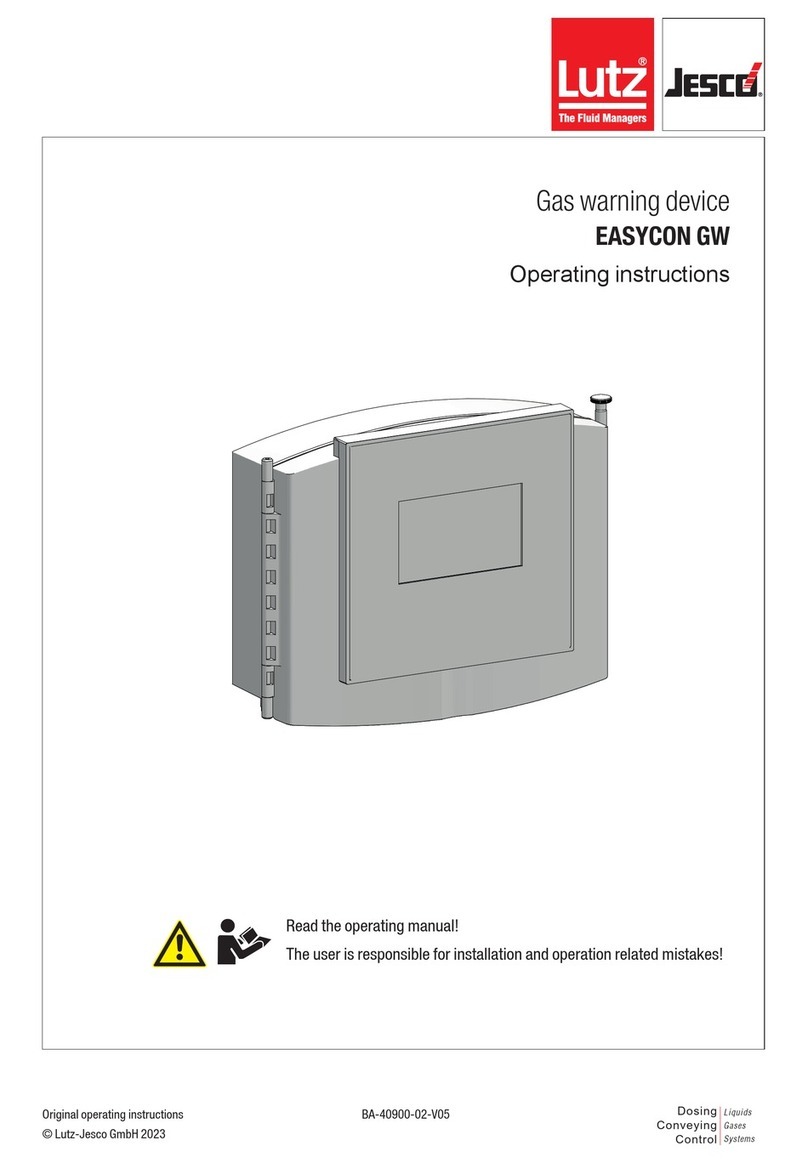
Lutz-Jesco
Lutz-Jesco EASYCON GW operating instructions
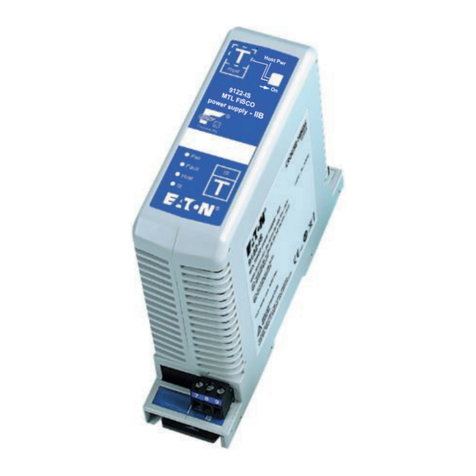
Eaton
Eaton 912 -IS Series instruction manual

Rockwell Automation
Rockwell Automation B Series user manual
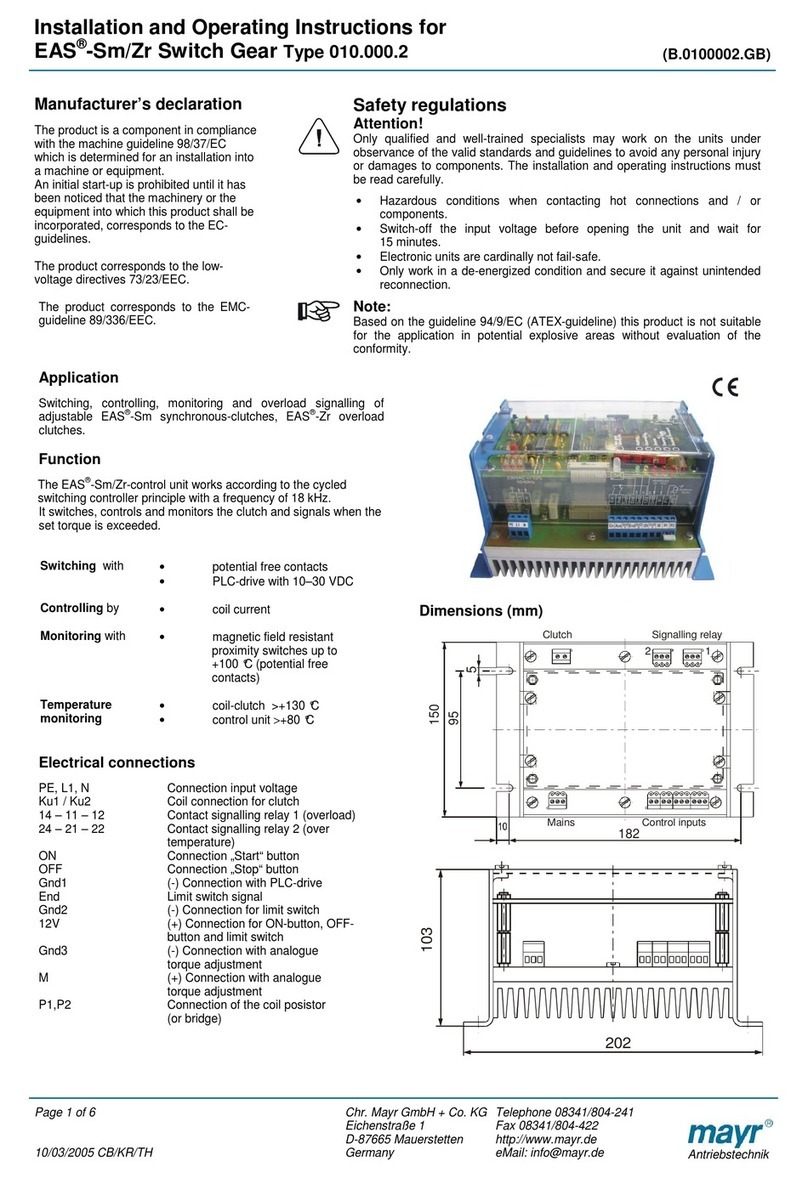
Mayr
Mayr EAS-Sm Installation and operating instructions
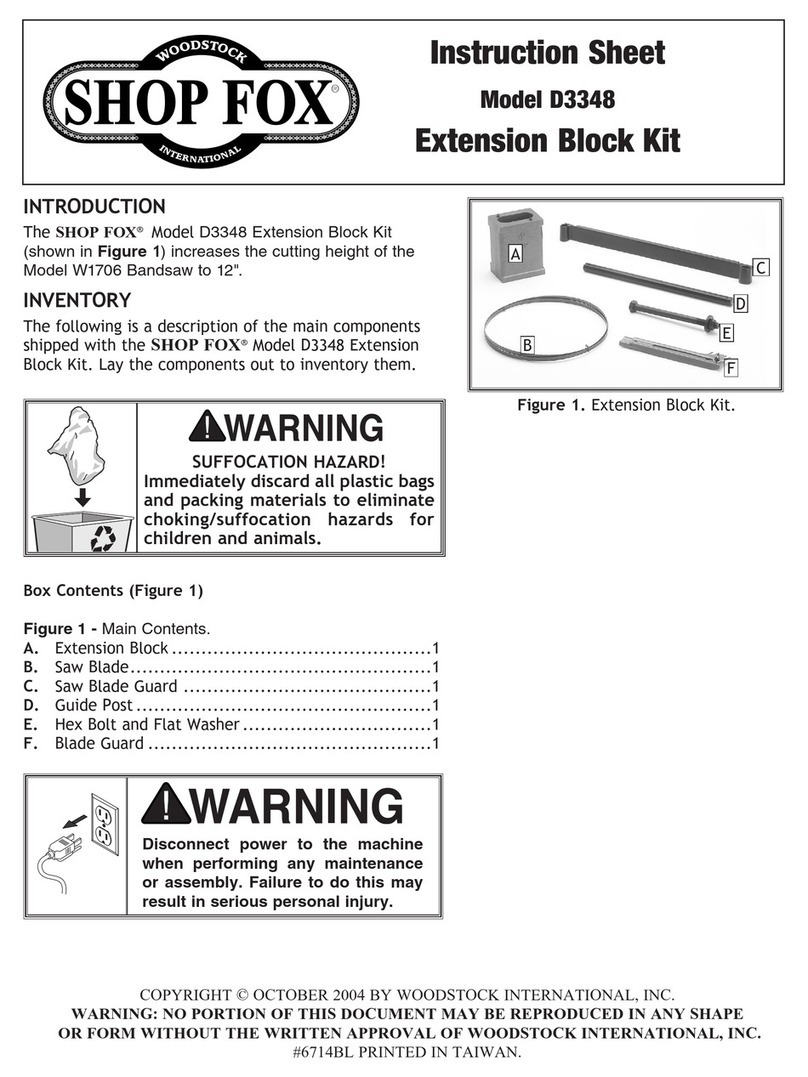
Woodstock
Woodstock SHOP FOX D3348 instruction sheet
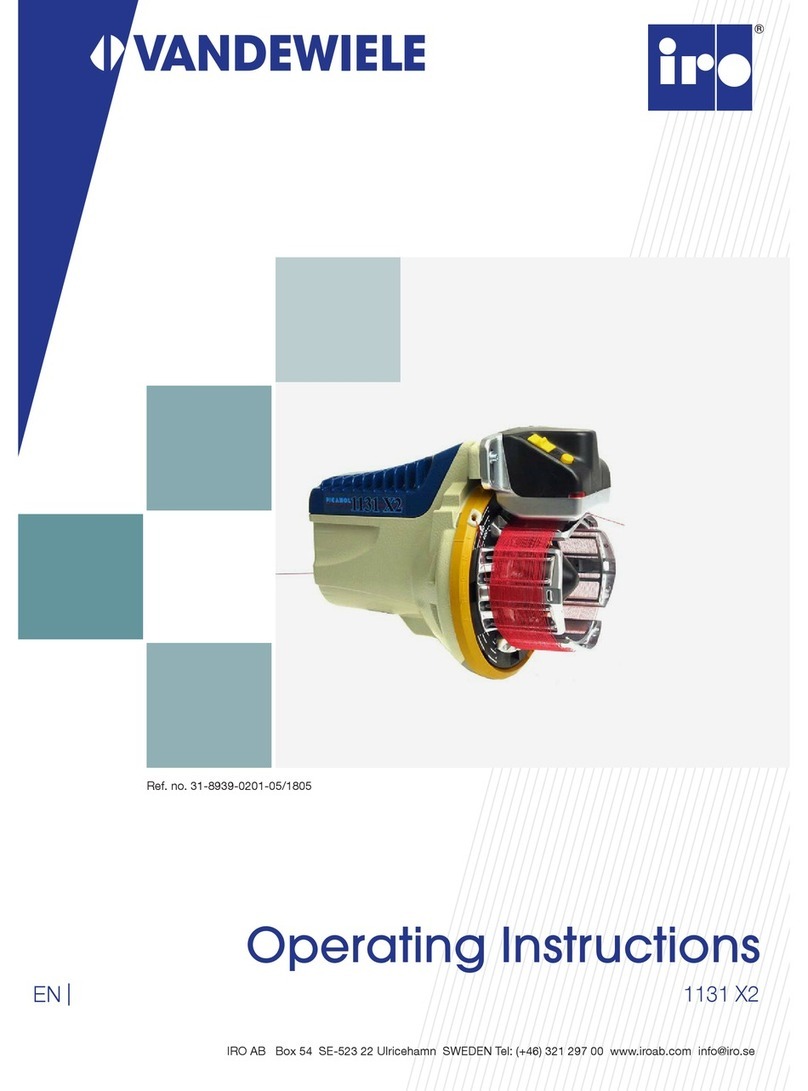
IRO
IRO 1131 X2 operating instructions
